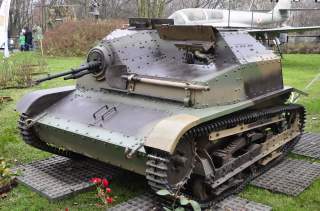How a Lone Polish Cadet Rampaged Through German Panzers
Edmund Roman Orlik rode in the puniest tankette imaginable.
Albrecht was interred in his family mausoleum, which was later vandalized by Soviet troops, who possibly assumed his black tanker’s uniform marked him as a member of the S.S.
Showdown at Sierakow
That evening of Sept. 18 and 19, the 9th Uhlan Regiment and 7th Mounted Rifles launched a surprise attack on German forces in Sierakow, just northwest of Warsaw. They seized the town, knocking out several Panzers, and captured 34 trucks and vital fuel supplies.
Anticipating a counter attack, the last three cannon-armed TKSs hastily deployed to a dugout ambush position on a wooded hill on the left flank. Three more Uhlan regiments, their attached batteries of 37-millimter anti-tank guns, and 75-millimeter howitzers from the 15th Light Artillery Regiment reinforced their position.
At 10:00 A.M., the German 1st Light Division obligingly counterattacked with dozens of Panzer 35(t)s from the 65th Panzer Battalion and 11th Panzer Regiment. An anti-tank gun knocked out the lead Panzer, causing the rest to fan out.
Sniping from 600 meters away on the flank, Orlik knocked out two tanks, then rolled down to ravine and dispatched another. He dismounted to capture two of the crew. He returned in time to encounter a second wave. Again, the diminutive tankette managed to knock out two or three German tanks without being spotted.
But then a Panzer turned its turret to face Orlik’s thinly-armored tank from 300 meters away. A 37-millimeter armor-piercing shell whizzed over the TKS—then a second. It would only take a single hit to blast apart the thinly-armored tankette. Orlik expended the last of his ammunition in a burst that finally disabled his attacker.
In all, Orlik claimed to have damaged or destroyed seven tanks at Sierakow, for a total tally of 13 tanks—making him one of the first tank aces in history. Suffering heavy losses to artillery as well, the few remaining German tanks retreated.
However, the high kill count at Sierakow seem typical of overclaiming—a phenomenon universal to all armies. Decades later Polish veterans of the battle cast doubt on the figure, claiming they could only recall 11 or 20 Panzers being destroyed by all arms.
However, in a rare exception to the general rule, German records show much heavier losses than the Poles claimed. Panzer Battalion 65 recorded 56 killed or wounded, including a company commander, and the loss of 27 tanks. Panzer Regiment 11 listed 11 tanks lost, including three knocked out by the anti-tank platoon of the 14th Uhlan regiment.
After the fight, Orlik and Nawrocki’s tankettes continued the retreat and finally arrived in Warsaw on the night of Sept. 19 with other elements of the Wielkopolska brigade—the only armored vehicles in the brigade to make it. The tankettes participated in the defense of the capital right until its surrender on Sept. 28.
Afterwards, Orlik evaded imprisonment, by some accounts joining the Polish resistance, though there are scant details as to his activities. After the war he studied architecture and designed the distinctive library and foreign student dormitories of the University of Łódź and a theater in Opole, before his death in 1982 to an accident.
Today a marker at the road intersection at Pociecha marks the site of his duel with the von Ratibor heir. Years later, Janusz Magnuski would chronicle Orlik’s exploits in Cockroaches Versus Panzers.
Orlik’s account does not square entirely with other members from his unit. However, there is little doubt that Polish tankette commanders together won a series of unlikely victories against a seemingly overwhelming foe, capitalizing on the dwarf-like stature of their armored vehicles.
This article by War is Boring originally appeared at War is Boring in 2018.
Image: Wikimedia

